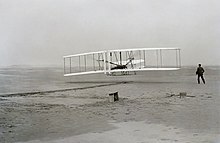Many Cultures have built devices that travel through the air, from the earliest projectiles such as stones and spears.,[1][2]the boomerang in Australia, the hot air Kongming lantern, and kites. There are early legends of human flight such as the story of Icarus, and Jamshid in Persian myth, and later, somewhat more credible claims of short-distance human flights appear, such as the flying automaton of Archytas of Tarentum (428–347 BC),[3] the winged flights of Abbas Ibn Firnas(810–887), Eilmer of Malmesbury (11th century), and the hot-air Passarola of Bartolomeu Lourenço de Gusmão (1685–1724).
The modern age of aviation began with the first untethered human lighter-than-air flight on November 21, 1783, in a hot air balloon designed by the Montgolfier brothers. The practicality of balloons was limited because they could only travel downwind. It was immediately recognized that a steerable, or dirigible, balloon was required. Jean-Pierre Blanchard flew the first human-powered dirigible in 1784 and crossed the English Channel in one in 1785.
In 1799 Sir George Cayley set forth the concept of the modern airplane as a fixed-wing flying machine with separate systems for lift, propulsion, and control.[4][5] Early dirigible developments included machine-powered propulsion (Henri Giffard, 1852), rigid frames (David Schwarz, 1896), and improved speed and maneuverability (Alberto Santos-Dumont, 1901)
While there are many competing claims for the earliest powered, heavier-than-air flight, the most widely-accepted date is December 17, 1903 by the Wright brothers. The Wright brothers were the first to fly in a powered and controlled aircraft. Previous flights were gliders (control but no power) or free flight (power but no control), but the Wright brothers combined both, setting the new standard in aviation records. Following this, the widespread adoption of aileronsversus wing warping made aircraft much easier to control, and only a decade later, at the start of World War I, heavier-than-air powered aircraft had become practical for reconnaissance, artillery spotting, and even attacks against ground positions.
Aircraft began to transport people and cargo as designs grew larger and more reliable. In contrast to small non-rigid blimps, giant rigid airshipsbecame the first aircraft to transport passengers and cargo over great distances. The best known aircraft of this type were manufactured by the German Zeppelin company.

